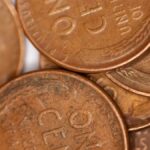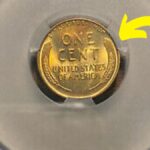The Lincoln Wheat Penny, one of the most iconic coins in U.S. history, has captivated collectors for over a century. Among the various editions, the 1943 Copper Lincoln Wheat Penny stands out due to a wartime error that makes it an incredibly rare and valuable coin. This article explores the origins of the Lincoln Wheat Penny, the error that led to the 1943 Copper Penny, how collectors can identify it, and the remarkable story behind a $701,000 auction sale.
The Origins of the Lincoln Wheat Penny
The Lincoln Wheat Penny was introduced in 1909 to celebrate the 100th anniversary of Abraham Lincoln’s birth. Designed by Victor David Brenner, the penny’s obverse features a profile of Lincoln, while the reverse displays two wheat stalks, symbolizing the agricultural heritage of the United States. This design was in circulation for nearly five decades, becoming one of the longest-running coin designs in American history.
While the design itself is well-known, it’s the errors and variations that occurred during its production, especially during wartime, that have made some Lincoln Wheat Pennies incredibly valuable.
The 1943 Copper Penny Error
In the midst of World War II, the U.S. Mint faced a shortage of copper, which was a critical material needed for military supplies. To conserve copper, the Mint switched to producing pennies from zinc-coated steel in 1943. However, due to a mix-up, a small number of copper blanks from 1942 were mistakenly used to strike pennies in 1943, resulting in a rare batch of copper pennies.
These 1943 copper pennies are considered a numismatic treasure, as they are not only rare but also represent a significant historical moment during the war. Today, they are highly sought after by collectors due to their scarcity and the fascinating story behind their creation.
The Discovery of the $701,000 Penny
One of the most famous discoveries of a 1943 copper penny occurred when a collector named Doug inherited a coin collection from his father. Among the collection was a 1943 copper penny. After expert verification, it was confirmed that this penny was one of the rare 1943 copper specimens, and it was later sold for a staggering $701,000 at auction. This sale generated significant attention and renewed interest in these rare coins, sparking a search among collectors for other potential finds.
How to Identify a 1943 Copper Penny
Identifying a 1943 copper penny is crucial for collectors looking to verify its authenticity. Here are some key characteristics to help distinguish a 1943 copper penny from its steel counterpart:
- Weight: A copper penny weighs approximately 3.11 grams, while the steel penny weighs only 2.7 grams.
- Color: Copper pennies have a reddish-brown hue, whereas steel pennies are silver-colored.
- Magnetism: Steel pennies are magnetic due to their iron content, while copper pennies are not magnetic.
- Edge: Steel pennies may show signs of wear, revealing a darker core beneath the zinc coating. Copper pennies, however, maintain a consistent reddish-brown color throughout.
By checking these characteristics, collectors can more easily identify a genuine 1943 copper penny from the more common steel version.
Value of 1943 Copper Pennies
The value of a 1943 copper penny can vary depending on its condition and mint mark. Below is a table summarizing the approximate value of 1943 copper pennies:
| Year | Mint Mark | Composition | Weight (grams) | Approximate Value |
|---|---|---|---|---|
| 1943 | None | Copper | 3.11 | Up to $701,000 |
| 1943 | D | Copper | 3.11 | Up to $840,000 |
| 1943 | S | Copper | 3.11 | Up to $504,000 |
| 1943 | None | Steel | 2.7 | Minimal |
These values are based on the condition of the coins and the market demand for rare specimens. The coins with the “D” and “S” mint marks tend to fetch higher prices due to their rarity and historical significance.
Other Valuable Lincoln Wheat Pennies
While the 1943 copper penny is the most famous error, several other Lincoln Wheat Pennies are highly valued among collectors:
- 1909-S VDB: Featuring the designer’s initials (VDB), this penny is worth thousands in well-preserved condition.
- 1914-D: Due to its limited production, the 1914-D penny can command up to $10,000 in excellent condition.
- 1922 “No D”: This penny, missing the Denver mint mark, is highly sought after for its unique feature.
- 1955 Double Die: Known for its distinctive doubling of the design, this penny is a prized find among collectors.
Each of these coins has its own unique story and value, further contributing to the enduring fascination with the Lincoln Wheat Penny.
Conclusion: A Treasure Worth Seeking
The Lincoln Wheat Penny is more than just a piece of currency; it is a cherished artifact of American history. The 1943 copper penny, in particular, stands as a symbol of wartime production and a reminder of the rare treasures that can be hidden in plain sight. Whether you’re a seasoned collector or just starting out, it’s worth taking a closer look at your change—who knows, you might just discover a piece of history worth a fortune.
By understanding how to identify rare coins like the 1943 copper penny and knowing their historical context, collectors can embark on an exciting journey into the world of numismatics.
Disclaimer: The information provided in this article is for educational and informational purposes only. Coin values and market trends may fluctuate, and readers are advised to consult a professional numismatist or financial advisor for investment decisions.





